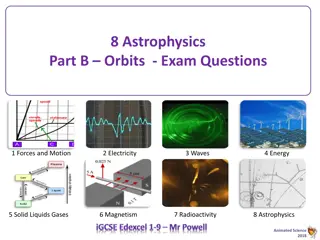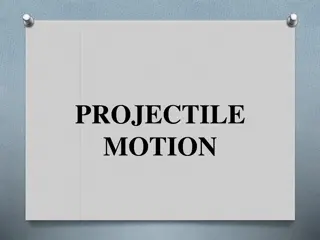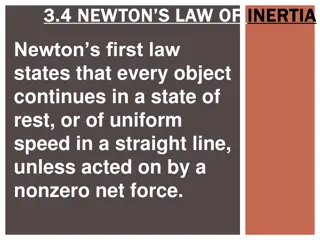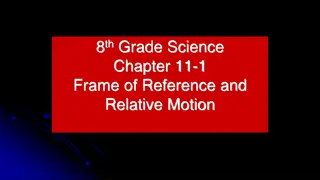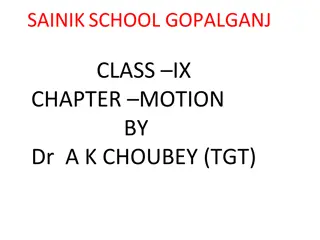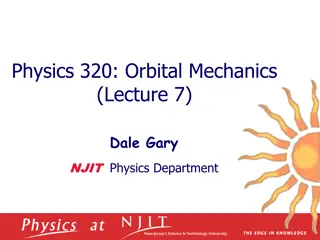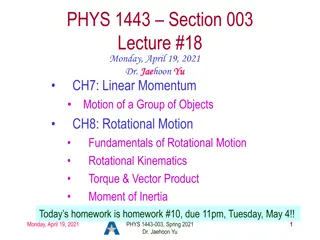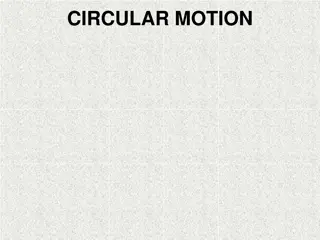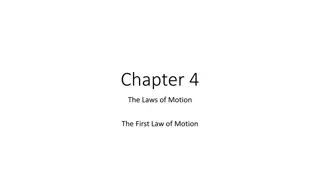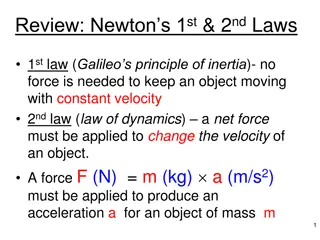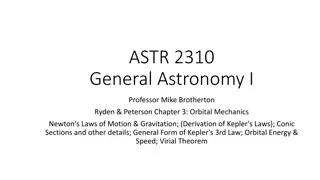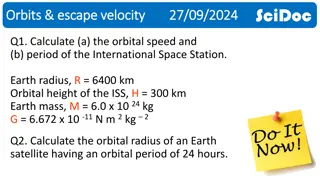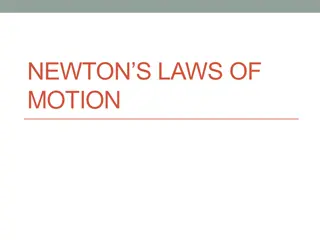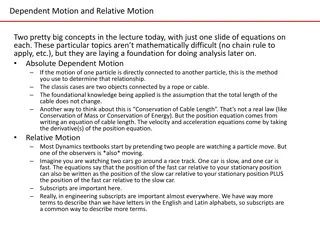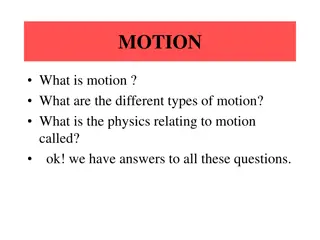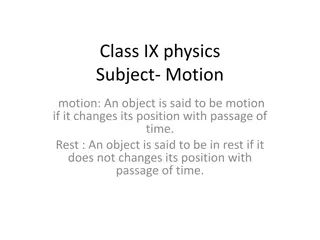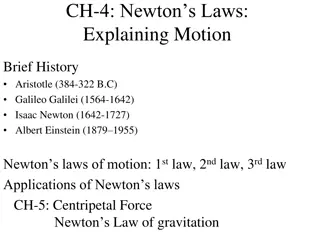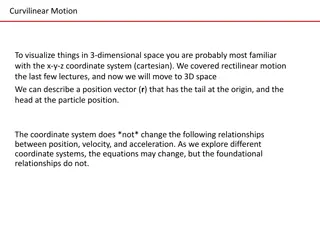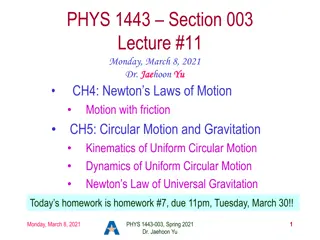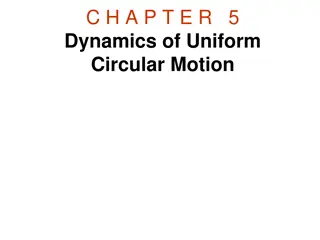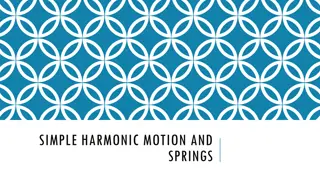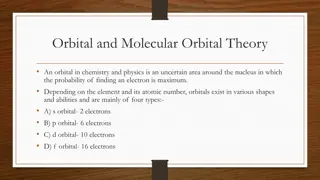Influence of Solar Activity and Orbital Motion on Terrestrial Atmosphere
Solar magnetic field reversal, wavelet spectral analysis, and proxies for solar activity index are discussed in relation to the joint effects of solar activity and solar orbital motion on the Earth's atmosphere. The study highlights the impact of solar cycles on terrestrial climate dynamics and temp
7 views • 16 slides
Orbits and Motion in Astrophysics
Explore the concept of orbits and motion in astrophysics, covering gravitational forces, planetary orbits, orbital speeds, and celestial phenomena like lunar eclipses. Delve into how objects move in space, the relationships between orbital speed, radius, and time period, and the dynamics of celestia
1 views • 14 slides
Projectile Motion: Characteristics, Examples, and Formulas
Projectile motion involves the motion of objects under the influence of gravity, with both vertical and horizontal components. This type of motion is seen in activities such as throwing a ball, kicking a football, or dropping objects. The motion is described by specific formulas, including calculati
3 views • 19 slides
Newton's First Law of Inertia
Newton's first law of inertia states that objects remain at rest or in uniform motion unless acted upon by an external force. This law, also known as the law of inertia, explains how objects tend to maintain their current state of motion unless influenced by an external force. Objects at rest stay a
0 views • 14 slides
Motion: Frames of Reference and Relative Motion
Motion is defined as a change in position over time. To describe motion accurately, one needs to understand frames of reference and relative motion. Frames of reference are systems of objects used to determine if something is in motion, while relative motion involves movement in relation to a refere
5 views • 14 slides
Motion: Concepts and Definitions in Physics
Motion in physics is defined as the change in position of an object over time. It involves concepts like rest, motion, distance, displacement, rate of motion, and types of motion. Rest and motion are relative to a reference point, while distance and displacement differ in their scalar and vector nat
3 views • 25 slides
Orbital Mechanics: Kepler's Laws, Center of Mass, and Equation of Motion
Exploring the fundamental concepts in orbital mechanics including Kepler's Laws, center of mass calculations, and equations of motion for celestial bodies. Topics covered include the laws of planetary motion, center of mass reference frame, and the concept of reduced mass in celestial mechanics.
1 views • 15 slides
Linear and Rotational Motion in Physics
Explore the concepts of linear momentum, center of mass, rotational motion, and angular displacement in physics. Learn how to determine the center of mass of objects, analyze motion of particle groups, and understand the conservation of momentum in systems under external forces. Delve into the funda
1 views • 18 slides
Circular Motion in Physics
Circular motion involves objects moving in a circular path at a constant speed, experiencing acceleration and centripetal force. This motion is characterized by angular speed, centripetal acceleration, and the necessary centripetal force. The concept of uniform circular motion and angular displaceme
3 views • 38 slides
Newton's First Law of Motion
Exploring the foundational concepts of motion and forces, this content delves into Isaac Newton's First Law of Motion. Describing how objects behave when the net force acting on them is zero, the law highlights the significance of inertia and balanced forces in determining an object's state of rest
0 views • 9 slides
Orbital Dynamics: Kepler's Laws and Newtonian Gravity
Delve into the fascinating world of orbital dynamics as we explore Kepler's Laws and Newtonian Gravity. From understanding the elliptical orbits of planets around the Sun to uncovering the role of gravity in shaping celestial motion, this journey will illuminate the fundamental principles governing
0 views • 18 slides
Vertical Motion and Gravity in Kinematics
Explore the principles of vertical motion and gravity in kinematics through scenarios involving throwing objects, free-fall motion, and calculating heights. Learn how to model vertical motion with acceleration due to gravity, find maximum heights of thrown objects, solve extended problems, and under
5 views • 12 slides
Newton's Laws of Motion
Explore the fundamental concepts of Newton's Laws of Motion, including net forces, combining forces, balanced versus unbalanced forces, and the concept of inertia. Learn how these principles explain the behavior of objects in motion and at rest, and discover the impact of mass on an object's resista
1 views • 17 slides
Joint Motion: Osteokinematic and Arthrokinematic Movements
Joint motion involves osteokinematic movements, which are under voluntary control and include flexion, extension, and more. End-feel sensations like bony, capsular, and springy block indicate different joint conditions. Arthrokinematic motion refers to how joint surfaces move during osteokinematic m
1 views • 17 slides
Newton's Laws of Motion
Newton's Laws of Motion explain the relationship between forces and motion. The first law states that an object in motion stays in motion unless acted upon by a net force, while the second law describes how force is related to an object's mass and acceleration. The third law states that for every ac
0 views • 21 slides
Orbital Dynamics: From Newton's Laws to Kepler's Laws
Exploring the fascinating realm of orbital dynamics, this content delves into the application of Newton's laws to explain Kepler's laws and the intricacies of orbital mechanics. Deriving Kepler's laws from Newton's law of gravitation involves advanced mathematics, while also emphasizing the signific
0 views • 25 slides
Orbital Mechanics and Satellites Overview
This content provides calculations for the orbital speed and period of the International Space Station, as well as the orbital radius of an Earth satellite with a 24-hour period. It explains the concept of artificial satellites, different types of orbits such as Low Earth Orbit (LEO), Medium Earth O
0 views • 17 slides
The Orbital Region: An Overview
The orbital region encompasses the orbits, eyelids, ciliary and tarsal glands, and anatomical borders. It consists of bony cavities protecting the eyeballs, eyelids that shield the eyes, and intricate structures like the lacrimal apparatus and muscles. Understanding the components and anatomical rel
0 views • 15 slides
Newton's Laws of Motion
Newton's Laws of Motion describe how objects behave in response to external forces. The first law states that objects in motion remain in motion unless acted upon by a force, while objects at rest stay at rest. The second law relates force, mass, and acceleration, showing how they are interconnected
0 views • 11 slides
Motion and Newton's Laws
Explore the concepts of motion, distance, speed, and velocity as they relate to Newton's Laws of Motion. Learn about measuring motion, calculating speed, graphing motion on distance-time graphs, and understanding velocity. Discover how motion is constant and how relative motion is used. Practice cal
0 views • 36 slides
Motion and Newton's Laws
Motion is the constant change in position of objects, measured by distance and displacement. Speed is the rate of motion, while velocity includes direction. Graphing motion helps visualize speed changes over time. Newton's Laws explain the behavior of objects in motion.
1 views • 38 slides
Dependent and Relative Motion in Dynamics
Dependent Motion and Relative Motion are fundamental concepts in Dynamics, providing the foundation for future analysis. Dependent Motion involves constraints like ropes or cables, while Relative Motion considers observers in motion. Dynamics involves applying a limited set of equations in diverse w
2 views • 18 slides
Motion: Types and Physics
Motion refers to a body changing position with respect to its surroundings. Different types of motion include linear, rotatory, and oscillatory motion. The physics relating to motion is called Mechanics, which comprises Dynamics and Kinematics. Scalars and vectors play a crucial role in describing t
1 views • 8 slides
Motion Perception in Computational Vision
In computational vision, the concept of motion opponency plays a crucial role in how the brain processes left and right motion inputs. By examining psychophysical results and the construction of motion opponent energy filters, we explore how the brain handles motion information. Additionally, the Ve
0 views • 23 slides
Motion in Physics: Definitions and Examples
An object is said to be in motion if it changes position with time, while rest implies no change. Learn about types of motion such as linear and circular, as well as vibratory motion and reference points. Explore how objects can be in motion relative to one reference point while at rest relative to
0 views • 4 slides
Orbital Motion and Circular Velocity in Physics
Explore the concept of orbital motion and circular velocity in physics, where we delve into the relationship between velocity and radius in circular motion with a constant centripetal force. Through Newton's 2nd Law and gravitational forces, we uncover the dependence of satellite speed on the radius
0 views • 13 slides
Evolution of Motion Theories: Aristotle to Einstein
Explore the progression of motion theories from Aristotle's belief in a force for motion to Galileo's discoveries on gravity, Newton's laws of motion, and Einstein's theories of relativity and quantum mechanics. Discover how our understanding of motion has evolved over the centuries, shaping the way
0 views • 20 slides
Android Motion Sensors for Carpal Tunnel Exercise Program
Patient Exercise Guide provides occupational therapy services for individuals with carpal tunnel syndrome (CTS), featuring post-surgery and non-surgery care guides for CTS recovery. The program assigns exercises to help users regain wrist strength and range of motion, utilizing Android motion sensor
0 views • 9 slides
Curvilinear Motion in 3D Space
curvilinear motion in 3D space involves describing particle position using a position vector, exploring relationships between position, velocity, and acceleration, and visualizing motion through coordinate systems. This concept delves into position vectors, displacement, velocity - both average and
0 views • 16 slides
PHYS 1443 Section 003 Lecture: Newton's Laws and Circular Motion Homework
Dive into the world of physics with Dr. Jae Jaehoon Yu as he covers Newton's Laws of Motion, motion with friction, circular motion, and gravitation. Stay on track with homework #7 due on March 30, and prepare for the mid-term exam. Explore kinematics and dynamics of uniform circular motion, Newton's
0 views • 17 slides
PROJECTILE MOTION
Fundamental concepts of projectile motion, where objects follow paths influenced by gravity and initial velocity. Dive into the separable X and Y motion components, superposition principle, initial velocity considerations, equations for motion, and trajectories on level ground. Discover the interpla
0 views • 8 slides
Projectile Motion
Learn about projectile motion, trajectory, and velocity vectors in this detailed guide by Kelly Rick. Explore how to solve problems involving projectile motion, understand the horizontal and vertical components, and analyze motion separately in the x and y directions. Discover the key steps to succe
1 views • 43 slides
2D Kinematic Equations of Motion and Projectile Motion
In this lecture on June 11, 2014, Dr. JaeJaehoon Yu delves into the realm of 2-dimensional motion, discussing the fundamentals of projectile motion and the application of 2D kinematic equations. This session of PHYS.1441-001, Summer 2014, is a deep dive into the intricacies of motion in two dimensio
0 views • 28 slides
Learning Stop Motion Animation
Discover the fascinating world of stop motion animation, from understanding the basics to creating your own films. Explore the types of animation, steps involved in making stop motion demos, and techniques used in stop motion studios. Unleash your creativity and bring static objects to life on scree
0 views • 16 slides
Dynamics of Circular Motion: Satellites, Gravity, and More
Explore the dynamics of uniform circular motion, from banked curves to satellite orbits and artificial gravity. Learn about the orbital speed of the Hubble Space Telescope, GPS technology, synchronous satellites, apparent weightlessness, and vertical circular motion in this informative content.
0 views • 10 slides
Understanding Simple Harmonic Motion and Springs
Explore the concept of Simple Harmonic Motion (SHM) and its relation to springs, unit circles, uniform circular motion, and damped harmonic motion. Discover the principles behind SHM, ideal springs, and the mathematical functions governing motion in this informative content.
0 views • 16 slides
Valence Bond Theory vs Molecular Orbital Theory: A Comparison
Explore the differences between Valence Bond Theory and Molecular Orbital Theory, including their postulates, strengths, and weaknesses. Valence Bond Theory, proposed by Linus Pauling, focuses on atomic orbital overlap, while Molecular Orbital Theory, introduced by Hund and Mullikan, emphasizes the
0 views • 16 slides
Kinematics: Describing Motion and Equations of Motion
Explore the principles of kinematics, including uniformly accelerated motion, interpreting graphs, and solving motion problems using equations. Learn about vectors, sign conventions, and analyze motion through various graph reviews. Understand the concepts of constant motion and acceleration, along
0 views • 13 slides
Understanding Molecular Orbital Theory and FTIR Spectroscopy
Learn about atomic and molecular orbitals, their shapes, and the concept of Highest Occupied Molecular Orbital (HOMO) and Lowest Unoccupied Molecular Orbital (LUMO). Explore the advantages of Fourier Transform Infrared (FTIR) spectroscopy over dispersive IR techniques.
0 views • 14 slides
Understanding Orbital Mechanics and Calculations
Explore examples and calculations related to orbital mechanics, including determining velocities and distances in various orbits around celestial bodies. Learn about geosynchronous orbits, spacecraft mass calculations, and orbital periods in different scenarios.
0 views • 8 slides

